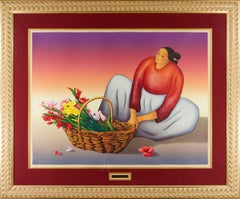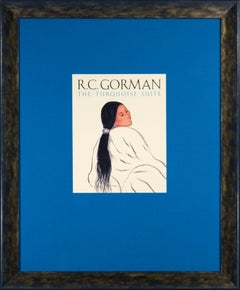Rudolph Carl Gorman Prints and Multiples
Rudolph Carl Gorman was an American artist, born on July 26, 1931, in Canyon de Chelly, Arizona. He was raised in a traditional hogan, on the Navajo Reservation. He became one of the Southwest USA's most famous and celebrated Native American artists. His signature works were Navajo women in a variety of poses. Referred to as the Picasso of American Indian Artists by The New York Times, his paintings are primarily of Native American women and characterized by fluid forms and vibrant colors, though he also worked in sculpture, ceramics and stone lithography. In 1973, the Metropolitan Museum of Art included several Rudolph’s works in an exhibition on Native American art and in 1986, Harvard University honored him for his notable contributions to American art and Native American culture. His admirers included Andy Warhol, who painted him on several occasions and who was among the many celebrities, who collected his art. He was also the author of a series of popular cookbooks. Gorman died on November 3, 2005, in Albuquerque, New Mexico.
Late 20th Century Realist Rudolph Carl Gorman Prints and Multiples
Lithograph
Late 20th Century Realist Rudolph Carl Gorman Prints and Multiples
Woodcut
1990s Contemporary Rudolph Carl Gorman Prints and Multiples
Lithograph
1990s Contemporary Rudolph Carl Gorman Prints and Multiples
Lithograph
1990s Contemporary Rudolph Carl Gorman Prints and Multiples
Lithograph
Late 20th Century Realist Rudolph Carl Gorman Prints and Multiples
Lithograph
Late 20th Century Realist Rudolph Carl Gorman Prints and Multiples
Screen
Late 20th Century Realist Rudolph Carl Gorman Prints and Multiples
Lithograph, Paper
Late 20th Century Realist Rudolph Carl Gorman Prints and Multiples
Lithograph, Paper
Late 20th Century Realist Rudolph Carl Gorman Prints and Multiples
Lithograph, Paper
1990s Contemporary Rudolph Carl Gorman Prints and Multiples
Paper, Lithograph
Late 20th Century Realist Rudolph Carl Gorman Prints and Multiples
Lithograph
Late 20th Century Realist Rudolph Carl Gorman Prints and Multiples
Screen
Late 20th Century Realist Rudolph Carl Gorman Prints and Multiples
Lithograph
Late 20th Century Realist Rudolph Carl Gorman Prints and Multiples
Lithograph
Late 20th Century Realist Rudolph Carl Gorman Prints and Multiples
Lithograph
Late 20th Century Realist Rudolph Carl Gorman Prints and Multiples
Lithograph
Late 20th Century Realist Rudolph Carl Gorman Prints and Multiples
Lithograph
1970s Contemporary Rudolph Carl Gorman Prints and Multiples
Lithograph
1950s Modern Rudolph Carl Gorman Prints and Multiples
Lithograph
Early 2000s Contemporary Rudolph Carl Gorman Prints and Multiples
Woodcut, Linocut
1990s Pop Art Rudolph Carl Gorman Prints and Multiples
Lithograph
Early 2000s Contemporary Rudolph Carl Gorman Prints and Multiples
Lithograph
1950s Modern Rudolph Carl Gorman Prints and Multiples
Lithograph
Mid-19th Century Rudolph Carl Gorman Prints and Multiples
Paper, Lithograph
1960s Surrealist Rudolph Carl Gorman Prints and Multiples
Lithograph
1960s Surrealist Rudolph Carl Gorman Prints and Multiples
Lithograph
1960s Surrealist Rudolph Carl Gorman Prints and Multiples
Lithograph
1960s Surrealist Rudolph Carl Gorman Prints and Multiples
Lithograph
1990s Modern Rudolph Carl Gorman Prints and Multiples
Woodcut
Mid-20th Century Modern Rudolph Carl Gorman Prints and Multiples
Woodcut
Late 20th Century Realist Rudolph Carl Gorman Prints and Multiples
Lithograph
Late 20th Century Realist Rudolph Carl Gorman Prints and Multiples
Lithograph
Late 20th Century Realist Rudolph Carl Gorman Prints and Multiples
Lithograph
1970s Impressionist Rudolph Carl Gorman Prints and Multiples
Lithograph
1990s Contemporary Rudolph Carl Gorman Prints and Multiples
Lithograph
Early 2000s Contemporary Rudolph Carl Gorman Prints and Multiples
Lithograph
1970s Contemporary Rudolph Carl Gorman Prints and Multiples
Lithograph


